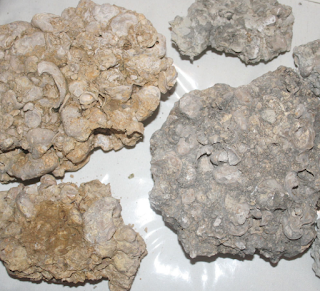Although rare in Central Texas, "coquina" limestone is occasionally evident, generally as part of the sedimentary deposit categorized as the "Cow Creek Limestone" geologic formation. Although it can be found in other "limestone" deposits. Coquina implies fossil-dense limestone. Limestone implies calcium carbonate rich material, and sea shells are calcium carbonate rich material. Therefore a coquina is a form of limestone. As with most limestone materials, coquina can be a detrital limestone (shell-dense soil transported during deposition) or non-detrital (shell-dense beach buried rapidly in place).
Various terms have been developed to describe fossil-dense limestone, therefore terminology can be confusing or even defined differently be different people. In general terms we might commonly use:
"Coquina": A limestone sedimentary deposit formed predominantly by marine shell animals and sand.
"Coquinite": A stong cemented coquina (rock), likely formed from notable burial under subsequent sedimentary deposits. Lithification by compaction.
"Coquinoid": A coquina where sand is more abundant in the matrix.
"Hash": Fossil hash or shell hash are terms used to described a coquina with notable variable (mixed) animal types and shell condition. High variability and condition of the animals at the time of burial generally implies a high hydraulic energy environment that broke up the sea fauna to produce a bed of random composition.
The samples at right were identified as coquina (or more likely coquinite) found in Texas, offered for sale on ebay.
This is a photograph of coquina found in Florida. This has the structure of a detrital deposit (deposition from high energy event).
High energy events producing fossil hash could conceivably be from large waves (meteor impact; earthquake) or underwater landslides caused by any number of possible events.
When a coquina is discovered with relatively intact postmortem shells (split bivalves) and low variability, it might imply rapid burial of a shell-dense beach. Some shell-dense beaches exist around the world including in Australia and the Caribbean. The shells wash ashore and collect over time.




No comments:
Post a Comment